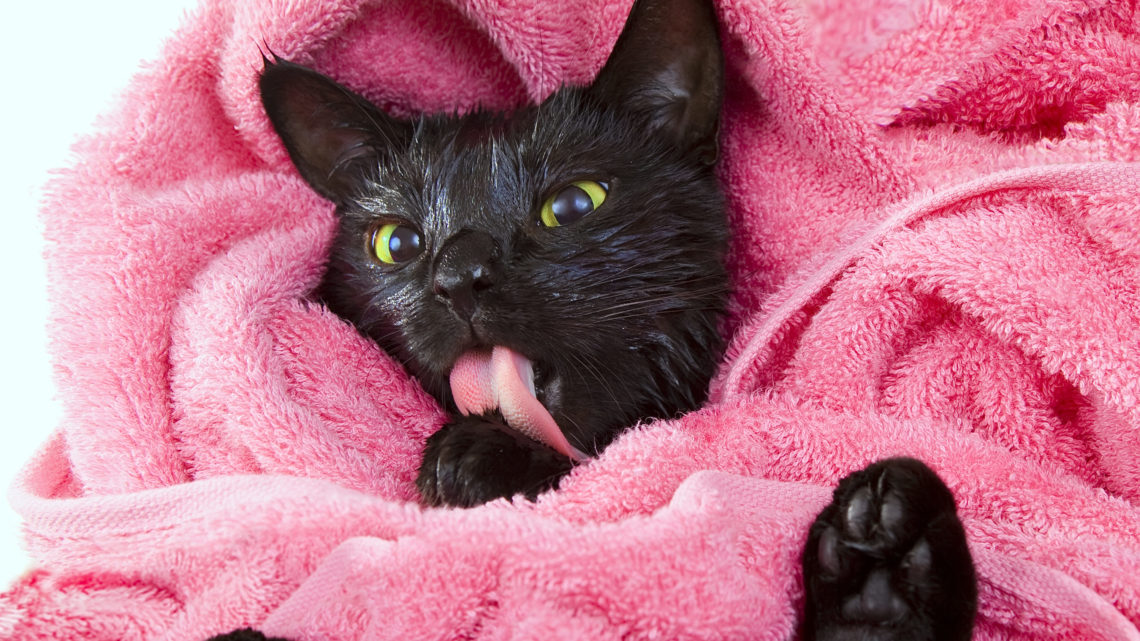Giving your cat a bath doesn’t have to be a headache. Following these simple steps will help things go smoothly and calmly.
As a rule, bathing a cat is no fun – for you or the cat. Our feline companions are notorious for their dislike of water, and for fighting their way out of baths in particular. But there are ways to take the stress out of giving your cat a bath, making it much less of an ordeal.
Prepare everything in advance
Clip your cat’s nails the day before to reduce the risk of getting scratched, and brush her fur shortly before bath time. If her coat is greasy or oily, sprinkle cornstarch on it before brushing; the cornstarch will absorb the oil and make cleaning easier.
 Pick the sink or tub that will be most comfortable for you and your assistant (see sidebar at left), and set out your cat’s shampoo, some towels and a washcloth. Use only natural, scent- and chemical-free shampoo formulated with a cat’s specific pH in mind. Anything else could dry out her skin and potentially cause irritation. Dilute the shampoo with warm water in a small plastic cup; this makes it easier to apply and rinse out. Bolster your cat’s feelings of security by putting down a wet towel or non-skid mat to keep her from slipping around.
Pick the sink or tub that will be most comfortable for you and your assistant (see sidebar at left), and set out your cat’s shampoo, some towels and a washcloth. Use only natural, scent- and chemical-free shampoo formulated with a cat’s specific pH in mind. Anything else could dry out her skin and potentially cause irritation. Dilute the shampoo with warm water in a small plastic cup; this makes it easier to apply and rinse out. Bolster your cat’s feelings of security by putting down a wet towel or non-skid mat to keep her from slipping around.
If you think your cat will react badly to running water, pre-fill two large plastic tubs or both sides of the sink with lukewarm water, nearly as deep as the cat’s belly, and set aside a plastic cup for scooping and pouring.
Dose your cat with Rescue Remedy shortly before the bath to help her stay calm. Put a drop on your thumb and lightly rub it into the top half of her inner ears, and on her paw pads.
Finally, keep your cat’s favorite treats on hand. You want to reward her at every point she remains calm.
Make the bath quick and thorough
- It’s important to create as positive an experience as you can, so start off by petting your cat the way she most enjoys, and giving her a treat.
- Then scoop her up, bring her to the bathing area and lower her gently into the sink or tub.
- While your assistant gently restrains her, soak her thoroughly from the neck down.
- Watch your cat carefully to gauge her distress level. Keep in mind that once you have the shampoo on, you’re going to need to get it off, so if you see her fear escalating while you’re wetting her down, and you think she might fight you, end the bath before you put the shampoo on. Reassure her, give her treats, dry her off and try again later.
 If your cat seems okay with being wetted down, apply the diluted shampoo and massage it in. If you’re using a faucet or hose, make sure the water pressure isn’t too strong and is about the same temperature with which you’d bathe a baby.
If your cat seems okay with being wetted down, apply the diluted shampoo and massage it in. If you’re using a faucet or hose, make sure the water pressure isn’t too strong and is about the same temperature with which you’d bathe a baby.- If your cat is sensitive to being touched in certain areas, such as the paws, and you don’t have to wash them, then don’t. You can work with her over time to help her become accustomed to having her feet handled, and when she’s ready, incorporate that into a bath whenever necessary.
- Although you don’t want to waste time, don’t just whip through the bathing process. Your cat can feel your energy, so move with purpose, but do so calmly, and talk to and reassure her throughout.
- Rinse your cat thoroughly. Leftover shampoo can be an irritant, so be sure to get it all off.
- Wrap her in one of the towels and give her a treat. Have your assistant hold her while you use the damp washcloth to gently wipe her face, if needed.
- Your cat will likely have a preference for either being held or put down to be dried. If she wants down, hold her carefully in the towel while lowering her to the counter or floor, so she is calmly released. You don’t want her anxiously jumping from your arms and potentially hurting herself, or clawing you, as she attempts to escape. Gently pat and rub your cat dry.
Last but not least, end the bath with another treat and a short play session with her favorite toy. This leaves her with a positive bath experience, and you with a clean and happy cat.







No Comment